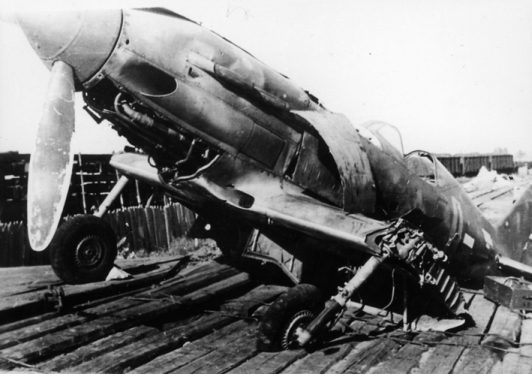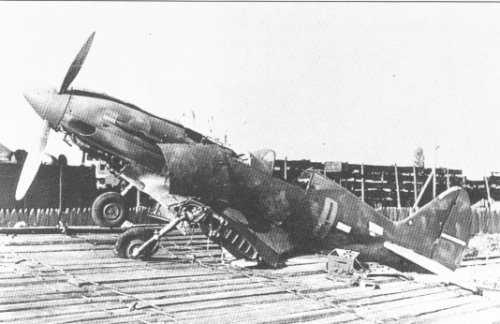~ Monthly Profile ~
August 2006

~ Monthly Profile ~
August 2006

One presumes that the images describing this aircraft, and the corresponding photographs, are known to just about every enthusiast of the VVS, and VVS modeling. These photos have been reproduced numerous times, and there appear to be several iterations of them. The various interpretation work relating to this aircraft is as broad as it is remarkable, and perhaps the subject has never really been illustrated the same way twice.
The immediate matter to take in mind, when considering any interpretation of the appearance, is as always the nature of the photography which provides the image. In this case, we have what is almost certainly a German photographer using German film. The images reproduce a number of classic features of this combination, such as the dark shade of all green colours, and so forth. It is also important to bear in mind that these are not the original photographs-- they have most definitely been manipulated and distorted in ways we cannot know, nor perhaps imagine. As was also typical for German photography of the time, it is highly probable that a coloured lens or filter was used in either shot, further disguising the original appearance.
With these caveats in mind, one can see that making a claim for a "definitive" appearance would be a bit silly. However, it also strikes me with great relevance that the tendency for-- what shall we call it?-- "over-analysis" is rife in such examples. This behaviour of over-analysis is quite wide-spread. As we observed in the last Monthly Profile, the artist reproducing an image of the subject I-16 was moved to apply all manner of complex patternation, lines and colours, for which there was simply no shred of evidence whatsoever. The same behaviour is routinely applied to this example, also. For myself, I can see no evidence at all for the appearance of multiple colours on the upper surface. There look to be two-- the base colour (which will be AII Green, surely), and a lighter shade over that, variously applied. One cannot know, given the difficulties of understanding the photography, what this colour might be with certainty. However, one can logically work out which colours might be most likely with a bit of applied logic. One can assume, firstly, that the colour must be an aviation lacquer (there is no evidence anywhere that non-aviation lacquers were used on Soviet aircraft); secondly, that this finish must have been available at the time (1941); thirdly, that the appearance of this colour would resemble what we see here on this type of film/camera combination. Assuming that this is, indeed, Soviet paint, then only one aviation lacquer fills all of these criteria to me-- AEh-9 Light Grey.
With respect to the other markings and details of this example, there are further areas of speculation. The star marking which looks to appear on the fin/rudder is only just visible; one therefore must estimate what the rest of the appearance might have been. On the evidence in view, it would look to be somewhat bloated, and applied at the so-called ground angle. The numeral is a source of vexation. It looks to be a "9", but with no possible understanding of the photograph image, we cannot say the colour. To me, again, it seems to resemble yellow the most, especially compared to yellow colours on other German photographs. However, other possibilities are certainly worth discussion. The wing undersurfaces are not in view, so the national marking is a (logical) guess. On the fuselage there are two large shipping labels (or, item descriptions, or some similar device). There is some kind of brace, strap, lamination, or other item applied both to the rudder and the upper fin leading edge (these are clearly 3D items, not paint); one assumes these are related to the recovery of the specimen and/or to shipping. Similarly, there are two "dot" or "blob" items with identical properties. It never ceases to amuse me when we see artists depict these items on a profile of the aircraft in its operational state! Surely, better attention to detail than this is a required minimum....
There are further missing bits. The canopy is gone, so any depiction of this is guesswork. The same is true of the lower cowling, and the outer wing sections. The derelict condition of the example in general does not lend itself to proper analysis of the specimen when operational.
In any case, the above profile is my own interpretation of a nebulous subject-- one, however, which I am sure is a large step in the right direction from previous efforts. A last bit of interest is the related question: "who, in fact, painted the appliqué colour onto this example"? Did a VVS unit or pilot do so, or someone else? This matter will be entertained in an upcoming article on captured examples like this one.

